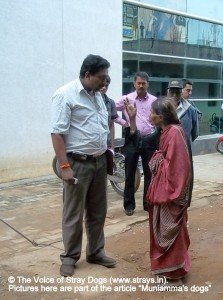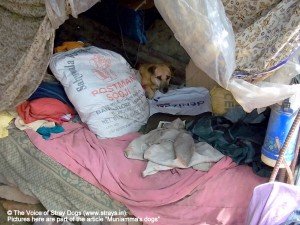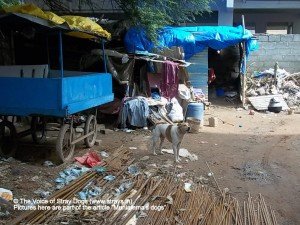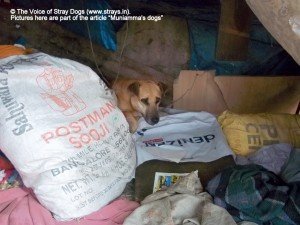There are many arguments one has read about how stray dogs in the urban environment ‘can’t coexist with people’. There’s no space – they attack kids – they make the place dirty. And the solution depending from whom you listen to, ranges from kills all of them – to – humanely euthanize them – to – ‘remove’ them and dump them outside the city. Reflecting this common thought even BBMP sought to implead itself in a Supreme Court case asking for dogs with mange or those deemed aggressive to be put down, and to ‘remove’ them from the city. Dangerous and illegal arguments.
A lot of the political & civic leadership (if there is indeed such a thing) says this ‘in the defense of the poor and defenseless, those who do not use cars and bikes but have to walk down the streets’. Everyone likes to speak for the poor.
But do they? And is there a relationship between urban poverty and urban stray dogs?
While there is a high intolerance for dogs, which comes out from the mouths of some of the
‘urban’ intelligentsia, political and administrative leadership and reflects what they say is the voice of the people – it is suspiciously the voice of the the urban middle/ higher middle class people and not of the people that they claim they speak for. The poor. Poverty does have a relationship with dogs, but it is hardly an adversarial relationship and we see this with the example of a person who lives below this abysmally low poverty line and yet shares her very limited resources, space and money with the dog that she also goes to the line for.
Incidentally there has been no uniform measure of poverty in India.
- According to a 2005 World Bank estimate, 41.6% of the total Indian population falls below the international poverty line of US$ 1.25 a day (PPP, in nominal terms INR 21.6 a day in urban areas and INR 14.3 in rural areas).
- The Planning Commission of India has accepted the Tendulkar Committee report which says that 37% of people in India live below the poverty line.
- The Arjun Sengupta Report (from National Commission for Enterprises in the Unorganized Sector) states that 77% of Indians live on less than Rs 20 a day (about $0.50 per day).
- The N.C. Saxena Committee report states that 50% of Indians live below the poverty line.
To put Karnataka in perspective, Karnataka ranks 12th in the list of poor states (Kerala, Goa & Punjab being the most prosperous). Karnataka with a population of 58.6M has 46.1% as proportion of poor with the ‘intensity of poverty’ indexed at 48.3 less than the national average of 53.5. Talking of urban poor in Bangalore i.e. the poor in Bangalore and the ones ‘supposedly’ intolerant towards dogs – the poverty figures are even more startling. They ‘need’ to spend no more than Rs. 31 on rent and conveyance, Rs. 18 on education, Rs. 25 on medicines or Rs 36.5 on vegetables per month (according to the Planning Commission). In rural (Bangalore) areas, this figure is even lower at Rs. 15 a day for all expenses put together! This cutoff is 3 times lower than the World Bank figures as to what should generally constitute a Poverty line cut-off, at US$ 1.25 a day. Anyone living in Bangalore, or any other Indian city would know how laughable this expectation is, if it were not tragic.
Surely when you’re starved of even a little space and anything close to human living conditions you’d be asking for the blood of the animal who wants to share your space? How do the strays dogs of Bangalore really correlate with the poverty of people. We think it does in 2 ways:
- Hypothesis 1: Lack of sanitation, waste disposal and waste management is proportional to poverty in the area. Not a cause, proportional. Dog population is proportional to poor waste disposal. i.e. urban dog population is related in some way to poverty if not directly proportional. ‘Proportional’ is the key word, not causal i.e. dogs don’t create the filth that causes poor sanitation where people stay. It is easy to see that more slums and lower income areas have more waste not picked up, and more dogs. This aspect will be covered in a later series of articles o waste management.
- Hypothesis 2: Poorer people are more tolerance to dogs than the yuppy aspirant – since they have a lesser disconnect with the animals living around them. Out on the streets you can’t but help feeling something that we’ve stated before – the disconnect between dogs and people seems to be not an urban-rural but a rich-poor phenomenon. The people who drive cars and bikes, throw their garbage across the road, have either moved up the ladder enough to loose all contact with animals or have recently moved out of that ecosystem. Now the dogs that were around now represent the ‘worst of India’ in some way. The part that you talk of shame with – other things such as the poverty and garbage on the roads (things that the dogs are a product of!). These are the people who wish to be mutually exclusive with dogs. On the other hand for the ones who hover around the poverty line, and urban poverty maybe more grinding in many ways and also squeezes man and dog together, there is little disconnect.
Maniamma’s is an example where her home is a flex-plastic roof, standing up on a bamboo and wood scaffolding, with a pile of rubble under it to give it height and keep it dry. You’d not wish to abuse a proud woman by calling her home a shanty. Her few possessions include an aluminum container that works as her food bowl, container and a lard, and a salvaged ‘thermos’ flask that maybe contained hot coffee someday, but now hangs in the hopes of one. The ‘bed’ made of cardboard’s covered with discarded linen and a sack of salvaged scrap cloth rags that acts both as her pillow and savings for a rainy day.
But Maniamma shares this 8-9 sq feet space with a dog, who lives with her.
The day we met her a dog van came to pick up the dog – on a complaint that there was a dog bite. The poor old woman out-numbered by the ‘authority’ of paper toting ‘babus’ had tears streaming down her eyes as she made a case of why the dog should not be removed – because this is not a ‘complaint’ dog but her child. Very quickly the dog catchers were joined in by the guards, managers & other employees from the gleaming glass building next door. This is the set that had complained to BBMP and had a grouse against Maniamma’s dog – since they walk past her house and he’d bark. All of them wanted the dog to be ‘removed’ – and as long as it was removed they did not care that it was killed or relocated.
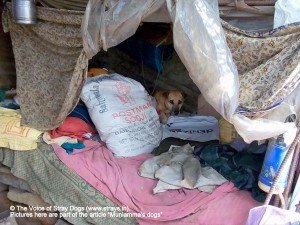
Rubble piled with cardboard piled with salvaged blankets and bedcovers are both the home and the bed
Muniamma would have none of it. Her tired opaque eyes glistened with tears and shone with a fire of one defending what is theirs. All the time her baby was perched in their bed quivering and watching with soulful eyes. 20 minutes later when finally the burly men, and assorted dolled up women, from ‘urban’ Bangalore, had beaten this poor old woman with their argument and the official complaint – the dog had disappeared! A dog-hunt ensued but he had escaped for good.
With a bunch of frustrated dog-catchers and disappointing office goers, there were only a few smiles that day – mine, and our teams.
Maniamma still stood tears streaming down her eyes. Inconsolable. She knew that will be another day and another complaint. And she and her dog might not be lucky that day. For Maniamma stays, as she has done for years, at the end of the drive to the basement parking of this gleaming glass building. She and her dogs were there before. The building just came up.


